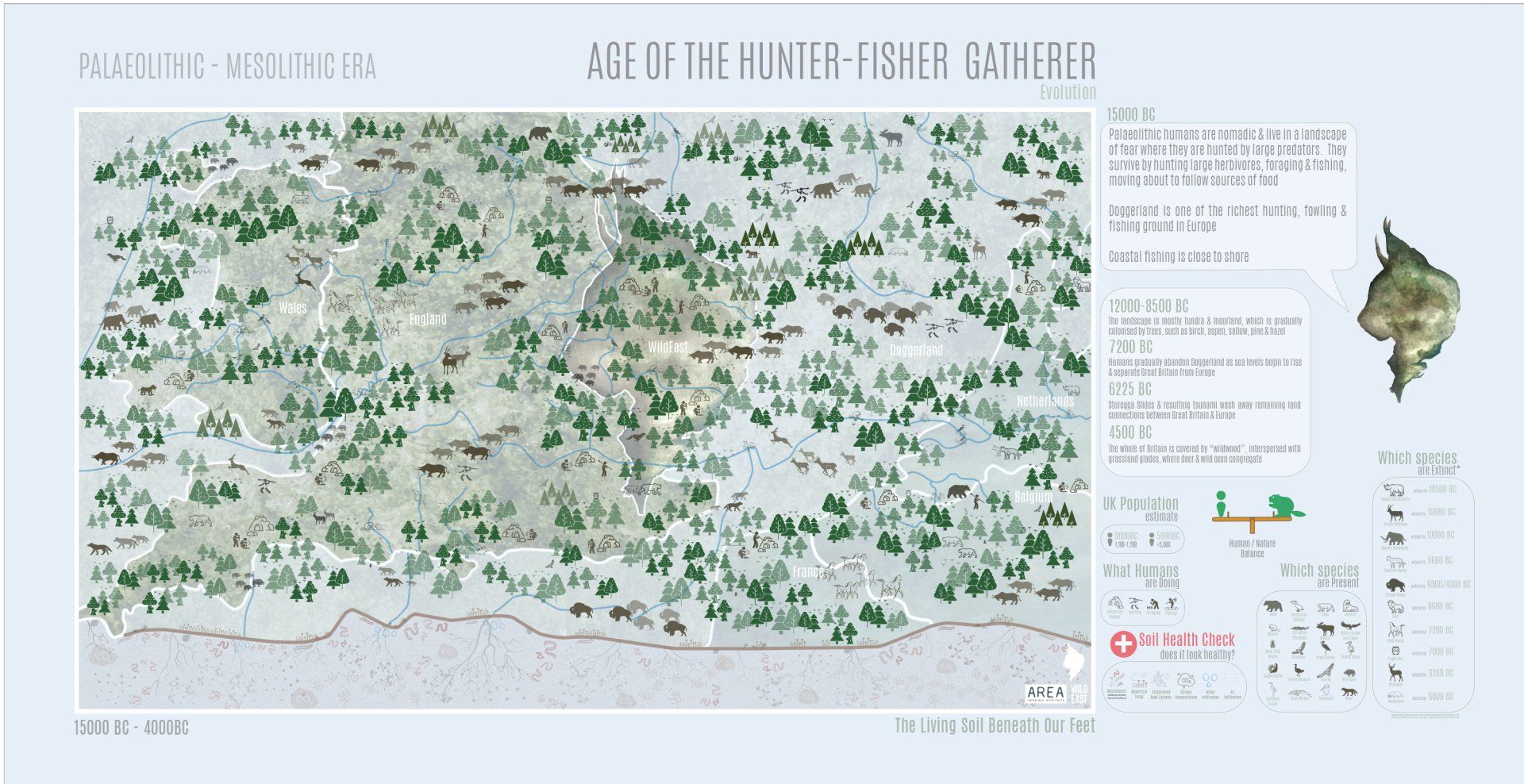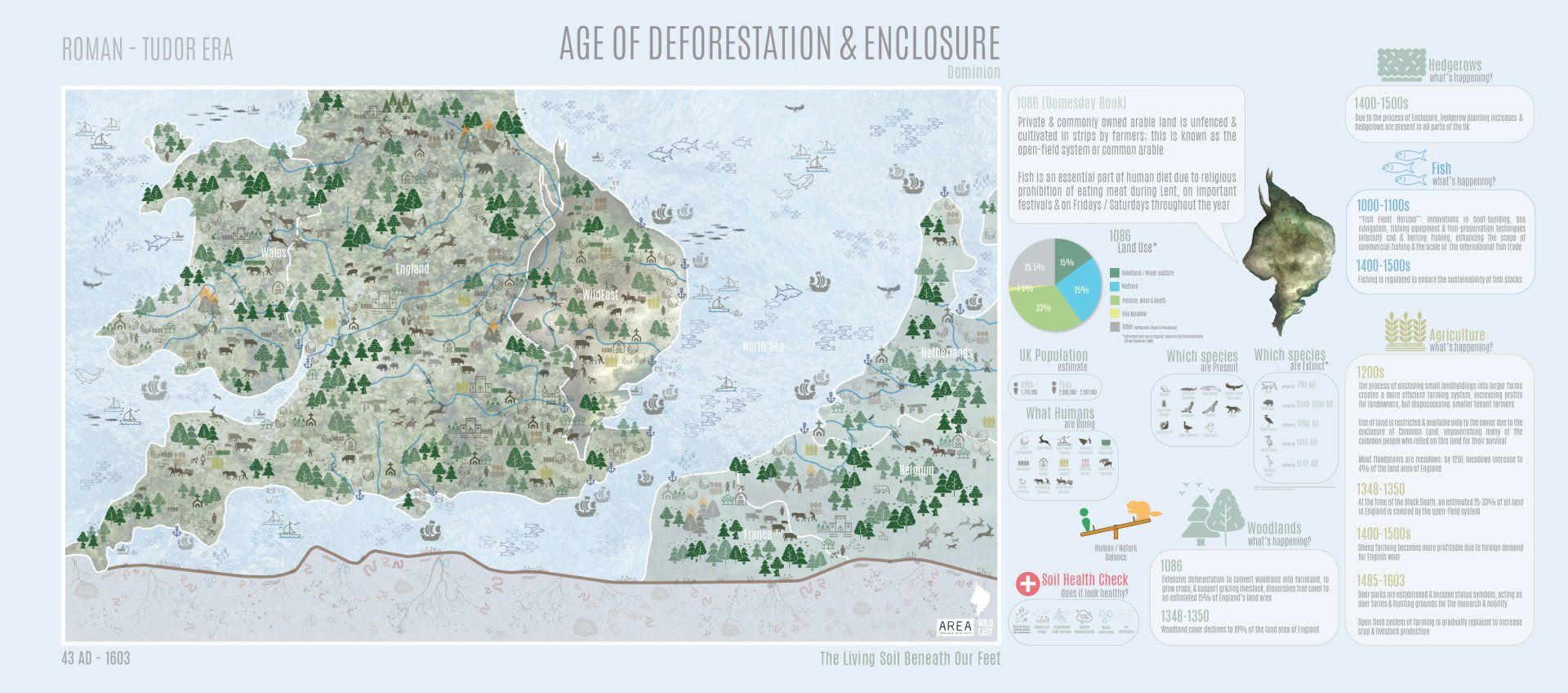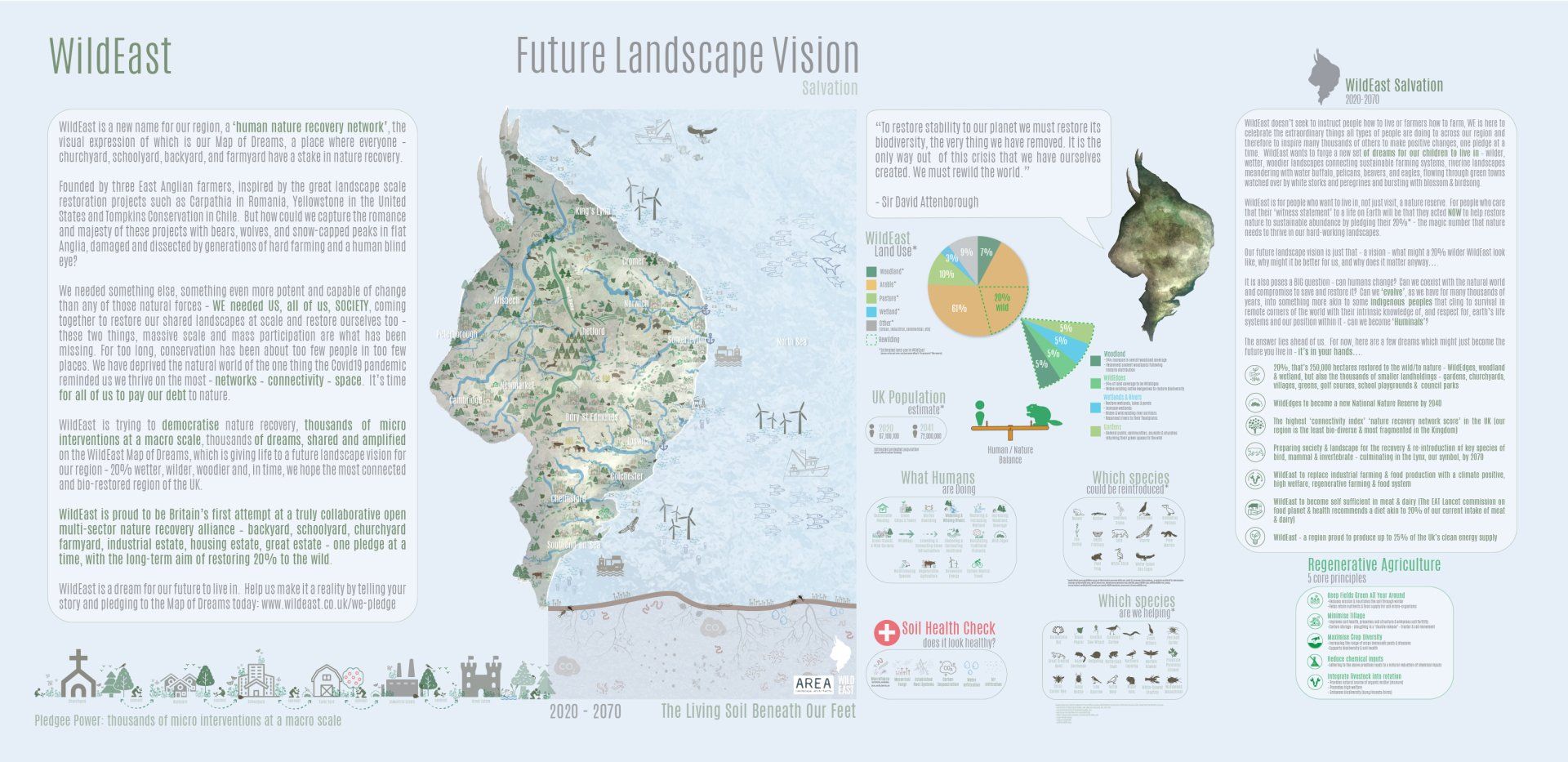ROAR - Illustrating the Map of Dreams
Here at WildEast we believe inspirational storytelling plays a pivotal role in encouraging individuals and communities to engage in nature recovery.
The illustrated wallscapes that adorn our brand new Education Centre capture the impacts of agricultural fishing and land management practices on the wildlife and soils of East Anglia.
In her first article for WildEast creator Jane Fitzgerald White tells the story behind the images.

Recently installed within the newly opened WildEast Education Centre, the WE Education Wallscapes are an artistic interpretation capturing the impacts of agricultural, fishing and land management practices on the wildlife and soils associated with East Anglia. Representing the region in the form of the WildEast Lynx, our vision is to illustrate why East Anglia’s nature is in such a perilous and critical state and to demonstrate how all of us as a community can work together to change this. WE believe that to learn how to start fixing the problem, we have to understand how we all got here in the first place.
The Wallscapes take us on a colourful and engaging journey through time, tracing human activities within East Anglia from 15000BC and projecting into the future to 2070. Each section of wallscape is designed as an individual chapter in time; there are six chapters, each one encapsulating a key era in agricultural, fishing and land use history, inviting us to explore the intrinsic relationship between the declining health of nature and developments in farming, fishing, land management, and settlement. Our story begins as humans gradually colonise the region, clearing woodlands and draining wetlands to build homes, grow crops and graze livestock. We discover when certain wildlife species disappear as their habitats are destroyed and they are hunted into extinction. The detrimental impacts of human enterprises above ground are depicted below ground, helping us to understand we are not only losing the wildlife we can see, but we are also losing a world of invisible wildlife, invaluable microscopic species in the very ground beneath our feet, species that keep our soils alive and healthy.

The wallscapes are designed as a wildlife version of ‘Where’s Wally?’ encouraging us to seek out and identify fauna and flora species as they gradually begin to disappear from our beloved landscapes. Many of the species featured are inspired by the list of extinct mammals, birds, fish and invertebrates which could be considered for reintroduction in the UK, as outlined in George Monbiot’s book Feral (2013). Wildlife which is specifically vulnerable within East Anglia today is also included. As we travel through time we learn that species such as beavers and Dalmatian Pelicans, which once thrived in our region before becoming extinct hundreds and even thousands of years ago, are now being successfully reintroduced.
Drawing on a diverse body of reference sources, including the Domesday Book of 1086 and the Corine Land Cover GIS data, each era tracks key changes in land use, allowing us to get a sense of the scale of territory nature has lost to human colonisation. Focussing primarily on woodland, wetland, arable, pasture and settlement, we learn that the wildwood and grassland glades which characterised the UK during the
Palaeolithic period had already been reduced to ‘islands of managed woodland’ by the time the Romans invaded Britain in 43AD, and that the Industrial and Agricultural Revolutions further reduced woodland cover to a mere 5% of UK land area by around 1875. Wetland has suffered a similar fate, and currently is reduced to occupying a mere 10% of its former territory.

Whilst most of the dramatic declines in our native fauna and flora populations have occurred within living memory, primarily in response to industrial agriculture, urban development, pollution, and the fragmentation and destruction of ecological habitats, the wallscapes highlight previous eras in history associated with wildlife decline and associated human endeavours to moderate their activities to prevent catastrophic species loss. During the 1400s, sea fishing was regulated in England to sustain severely depleted fish stocks. This depletion was due to a combination of the high demand for fish, which was an essential part of the human diet, and innovations in sail trawlers, fishing and preserving techniques. Whilst regulation to sustain fish stocks continues to our current era, it has failed to stem the rapid decline in North Sea species such as herring (>99% decline between 1960-mid-1970s), cod (68% decline between 1970-1990) and haddock (commercially extinct by late 1800s), a situation caused by overfishing and climate change.
Some land management practices in past eras was incidentally beneficial and made a significant contribution to providing meaningful space for nature: during a hundred year period, between 1750 and 1850, an estimated 200,000 miles of hedgerows were planted throughout England as part of the process of Enclosure. This figure equates to all hedgerows planted during the previous 500 years. From 1875 until 1898, orchards increased by an estimated 45% in England. Unfortunately, these valuable habitats fell victim to changes in land management practice during the following era: between 1945 and 1992, 50% of UK native hedgerows are removed to increase field size, equating to a distance of 500,000km. Many surviving hedgerows are kept ‘tidy’, their potential for ecological habitat inhibited by intensive management. By 1995, 75% of UK orchards had been removed, a staggering depletion of a valuable habitat.


Storytelling is intrinsic to human society, and the narrative structures we are drawn to follow a familiar pattern: we are lost in the dark forest, we encounter a series of challenges which must be overcome and learn through our experiences the vital skills to assist us in restoring a sense of balance to our world. This balance is the ‘happy ending’. The WE Education Wallscapes are envisioned as such a story with six chapters, four of which don’t end very happily for nature. The fifth chapter, covering the period from 1901 until 2019, concludes by offering us the tinniest glimmer of hope as society develops some environmental awareness. The sixth and final chapter takes us on the next stage of our journey, beginning in 2020 and continuing up to 2070, illustrating a ‘Future Landscape Vision’ where 20% of the space taken from nature is returned to nature.
Outlining WildEast’s aim to create a ‘human nature recovery network’, this final wallscape promotes the democratisation of nature restoration by encouraging all members of the community to collaborate in making thousands of ‘micro interventions at a macro scale’ to transform East Anglia into the most connected and bio-restored region in the UK. The past is a story formed by the multiple generations that lived before ours. The last chapter is ours to write and has massive implications on the future lives of the humans and wildlife that will come after us. WE believe a happy outcome is possible if we learn the lessons associated with past practices and develop the skills needed to restore a sense of balance to the world we share with nature.
Jane Fitzgerald White
JFW is an independent landscape architect, consultant and writer based in Suffolk
The WE Education Wallscapes is a collaboration between WilldEast and Area Landscape Architects.

New Paragraph
WildEast Blog

Powered by LocaliQ
Follow Us
SIGN UP FOR NEWS & UPDATES
Newsletter Sign Up
Thank you for signing up to our newsletter.
Please try again later.
Privacy / Terms & Conditions / Sitemap
